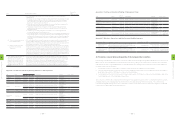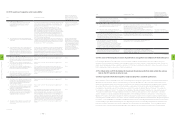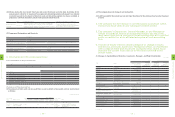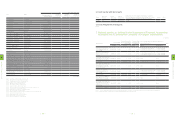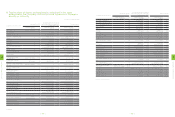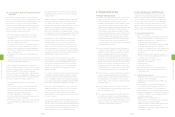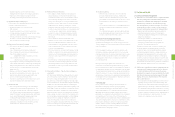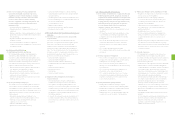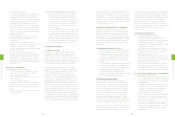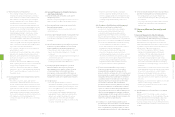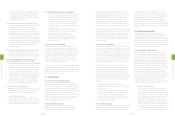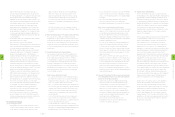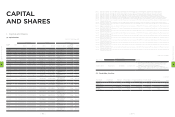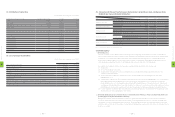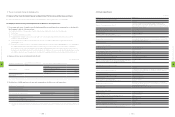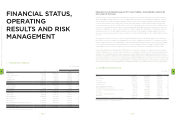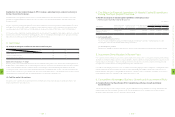HTC 2011 Annual Report Download - page 46
Download and view the complete annual report
Please find page 46 of the 2011 HTC annual report below. You can navigate through the pages in the report by either clicking on the pages listed below, or by using the keyword search tool below to find specific information within the annual report.
• Employees are strictly required to wear basic
protective gear when handling chemicals (such as
protective goggles and gloves), and required to carry
out registration and control measures when entering
or leaving storage areas and taking items out of
storage.
4-4. Greenhouse Gas Emissions and Management
(1) Greenhouse gas inventory and disclosure
In response to international concern regarding
greenhouse gases and global warming, and in
cooperation with the greenhouse gas reduction
guidance plan of the Ministry of Economic Affairs'
Industrial Development Bureau, HTC has implemented
inventories of the sources and volumes of its greenhouse
gas emissions in accordance with IISO14064-1 standards.
The results of its implementation include the following:
• Inventorying greenhouse gas emissions allows
better understanding of energy use and is helpful in
establishing energy-saving strategies.
• At the beginning of each year, HTC implements
inspection of its greenhouse gas inventory by a
certification agency and receives an inventory certificate.
• HTC discloses information on its greenhouse gas
emissions each year through the Taiwan Environmental
Protection Agency's National Greenhouse Gas
Registration Platform and information disclosure
through international nonprofit organizations.
(2) HTC has inventoried and disclosed the extent of
its greenhouse gas emissions since 2008, within
an organizational boundary that includes all of its
production facilities in Taiwan. Since 2010, inventory and
disclosure has also included its plants in mainland China,
along with verification by outside agencies. Electrical
consumption has been the main source of greenhouse
emissions, which in 2010 amounted to 33,800 metric
tons of CO2e. In the future, HTC will implement
greenhouse emissions inventory and disclosure, along
with external verification, for all subsidiaries under its
control, to continue the monitoring and measurement
of its greenhouse gas emissions, and will implement the
ISO 50001 energy management standard, combining
energy management with energy reduction measures to
effectively enhance its energy efficiency and reduce the
volume of its greenhouse gas emissions.
(3) In addition to its yearly inventory and disclosure of
greenhouse gas emissions, HTC also responds annually
to the demands of the international Carbon Disclosure
Project organization by reporting regularly on carbon
risk and planning and systems for carbon management.
(4) Concrete measures taken by HTC to reduce greenhouse
gas emissions during employee commutes are below:
• Encouraging greater use of public transport by
employees and promoting less driving or taking taxis
for commutes.
• Using videoconferencing to reduce carbon emissions
resulting from transportation and lodging during
business trips.
(5) Energy and Resource Consumption and
Saving
5-1. Use and Management of Electrical Energy
(1) Establishing energy-saving strategies, enhancing
operating efficiency, and reducing energy consumption
HTC has established systems to ensure the repair
and maintenance of its high-power electrical power
supply, while adopting technologies to reduce electrical
consumption that have allowed an annual reduction in
CO2 emissions of about 640 metric tons.
• In 2011 HTC introduced the ISO 50001 energy
management standard and passed third-party
certification. HTC has drafted and phased in an
energy-reduction action plan through the use
of systematic energy management and energy-
reduction policies; in 2011 it added robotic assembly-
line systems for assembly and inspection, bringing
major reductions in average energy costs per unit of
production.
• Implementation of energy-reduction plans systemically
and at management levels has reduced energy wasted
as a result of routine practices or misinformation.
• Measurement and appraisal has been undertaken
of energy consumption levels of old drinking water
dispensers and the economic benefits of switching to
new ones.
• Frequency converters have been added to motors and
pumps to reduce energy consumption.
• Heat recycling facilities have been set up to replace
electricity consumption.
(2) Overall Management of Energy Reduction in Lighting
Systems
Beginning in 2010, the old, high-energy-consumption
T8/T9 fluorescent lamps in offices and plants in Taoyuan,
Xindian, and Tainan have been gradually replaced by
more energy-efficient T5 lamps and LEDs. This has
resulted in energy savings of 210,240 KWH/year and the
environmental benefit of a reduction of 133.7 metric tons
of CO2e.
(2) Waste reduction, recycling, and reuse
• HTC's strategy for waste reduction begins with
reducing waste production and rigorous sorting of
waste. Production of waste is reduced at the source,
and to improve recycling rates we give the highest
priority to material reuse. In 2011, all parts of plastic
assembly panels that could be recovered were
reused, and the remaining recyclable materials were
outsourced to a recovery enterprise approved by the
Ministry of Economic Affairs' Industrial Development
Bureau for waste purification and processing into
industrial-grade materials for further use. We have
achieved an average annual recycling rate of 60
percent. Other waste is dealt with by physical sorting
to increase reusability, and is subject to final disposal
only when there is no possibility of further reuse. HTC
carries out regular online reporting with regard to the
status of production and temporary storage of waste
in accordance with laws and regulations.
• HTC continues to promote activities for reduction of
general domestic waste.
• Used batteries, fluorescent light tubes, and computer
and electronics equipment are also fully recycled.
• Employees, guests, and persons arriving on business
at HTC are encouraged to use eco-friendly reusable
tableware and cups.
• In April 2011 HTC promoted a "LOHAS Green Energy
Week," organizing a series of events on environmental,
energy saving, and health themes, including, in
response to World Environment Day, encouraging
employees to use eco-cups and tableware and asking
them to urge fellow employees to reduce their use of
throwaway utensils.
(3) Ensuring appropriate waste management by suppliers
and contractors
• HTC carries out surveys, audits, and risk-level
assessments to differentiate between the firms who
provide its parts and assemblies with respect to their
performance in the areas of environmental protection,
health and safety, and corporate social responsibility.
• HTC sets up survey and audit mechanisms for firms
handling waste clearance and disposal, maintaining
files on each and implementing risk-level assessments.
• HTC engages in control and management of
construction waste through both source control and
end control.
4-3. Use and Management of Harmful Substances
and Chemical Products
(1) Environmentally safe compounds used in gas fire
extinguishing system:
Halide fire extinguishing equipment has been chosen to
replace the previous carbon-dioxide based systems.
(2) Environmental batteries have been chosen for fire-
fighting illuminating lamps:
Lead-acid batteries have been replaced with nickel-
cadmium batteries.
(3) Chemical agent management part of cooling tower setup:
Cooling tower cleaning and disinfecting agents have
received safety certification or conform with related
standards.
(4) Specially appointed persons responsible for inventory,
inspection tours, and confirmation of the following
matters regarding chemical agent management:
• Types, amounts, and storage conditions of chemical
agents used (including management of storage
containers).
• Complete and accurate labeling of chemical agents at
units where they are used.
• Whether information on chemical agents is complete,
including relevant SDS (Safety Data Sheets).
(5) Ensuring appropriate management of chemical
agents by suppliers and contractors: Chemical
agent management by suppliers includes the areas
of environmental protection, health and safety,
and corporate social responsibility. HTC carries out
surveys, audits, and risk-level assessments of internal
management systems at its suppliers and contractors.
(6) Storage and Use:
• HTC holds general education courses for
"identification and labeling of dangerous substances,"
"classification and labeling of chemical agents," and
use of "Safety Data Sheets." Courses are planned to
include new HTC employees.
• Chemical agents and flammable materials are all
appropriately stored in dedicated industrial safety
cabinets, with exhaust fans designed to remove
volatile gases out of the safety zone. Regular
inspection tours check on storage environments and
the safety of related facilities.
4
CORPORATE GOVERNANCE
| 88 |
4
CORPORATE GOVERNANCE
| 89 |


